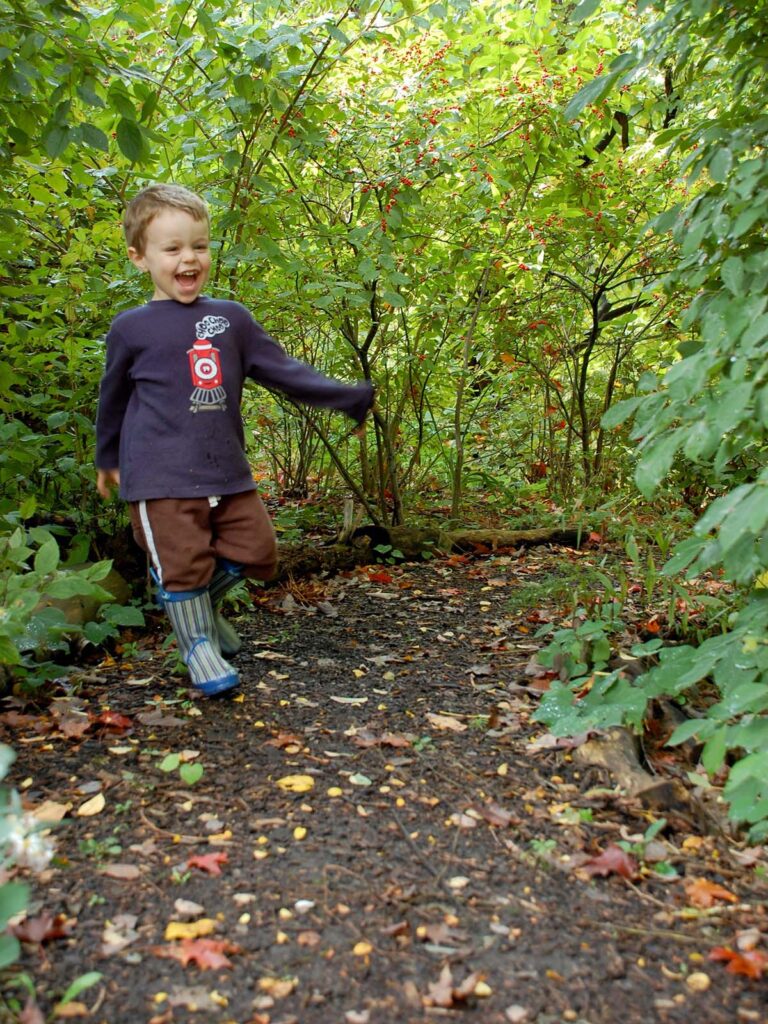
Our grandson loves our forest-y front yard. Who says kids need huge lawns to have a good time?
Somehow, in these modern times, we’ve come to think that only sports justifies being outside, so we need to have large lawns. (But our communities of course need to provide an abundance of parks for kids to play in.)
But people have also come to believe that nature (unlike human creations such as cars) must be risk-free — and that the natural world is full of dangers.
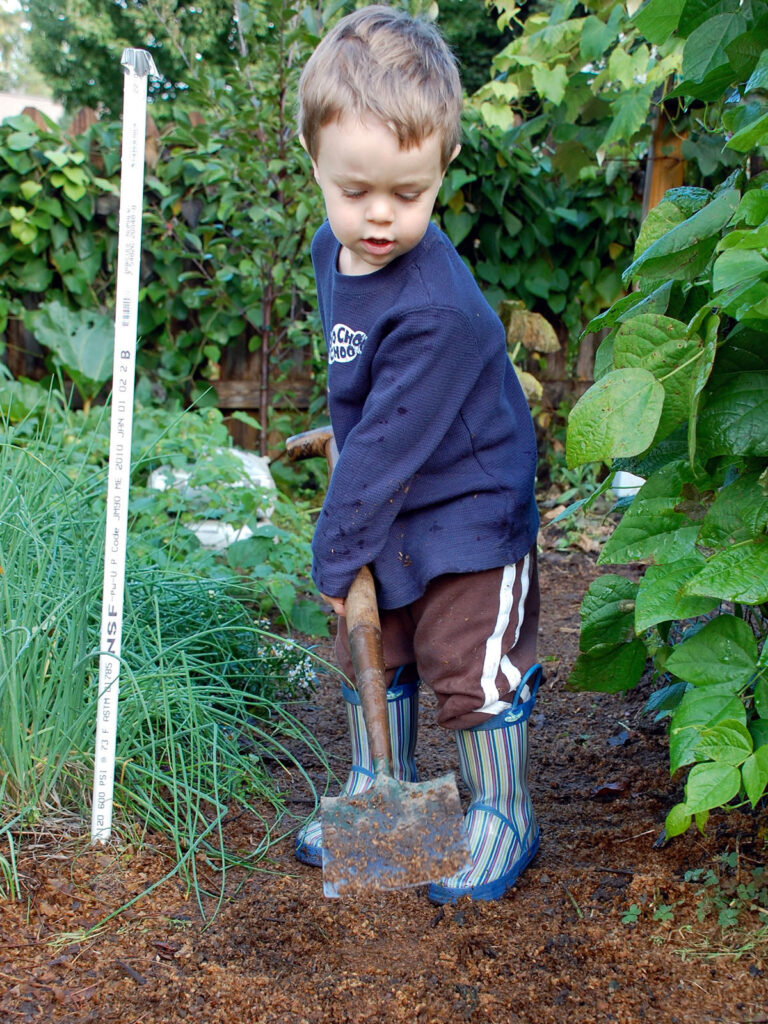
Children love to do “real work” — especially if it involves dirt and mulch. This digging work kept our oldest grandson engaged for quite a while in Our Edible Garden.
There’s always something to explore in the habitat garden in every season!
Beyond the habitat garden

But our own yards aren’t enough. Children must experience nature in a larger setting. When we were visiting in North Carolina, we took our oldest grandson to a local state park.
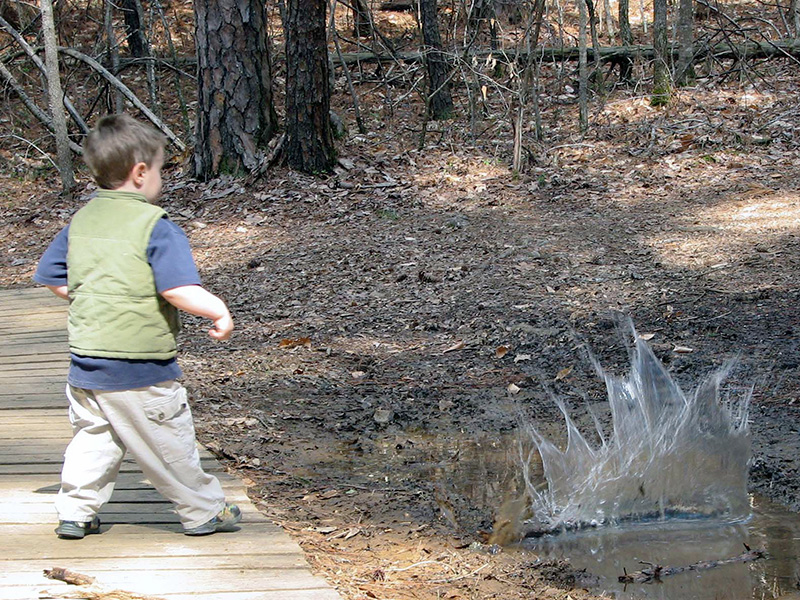
How many children these days have a chance to indulge in the age-old activity of throwing sticks or stones into water? They create such a satisfying splash!
It was a challenge to convince him to leave this fascinating game and continue on our walk.
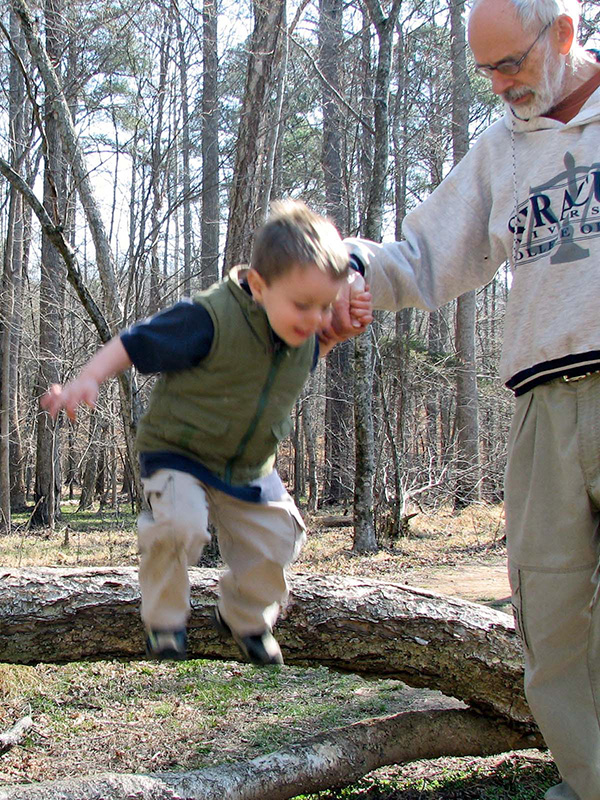
Being out in nature is a wonderful way to bond and to experience life.
Even a patch of special grass in a meadow is interesting for kids.
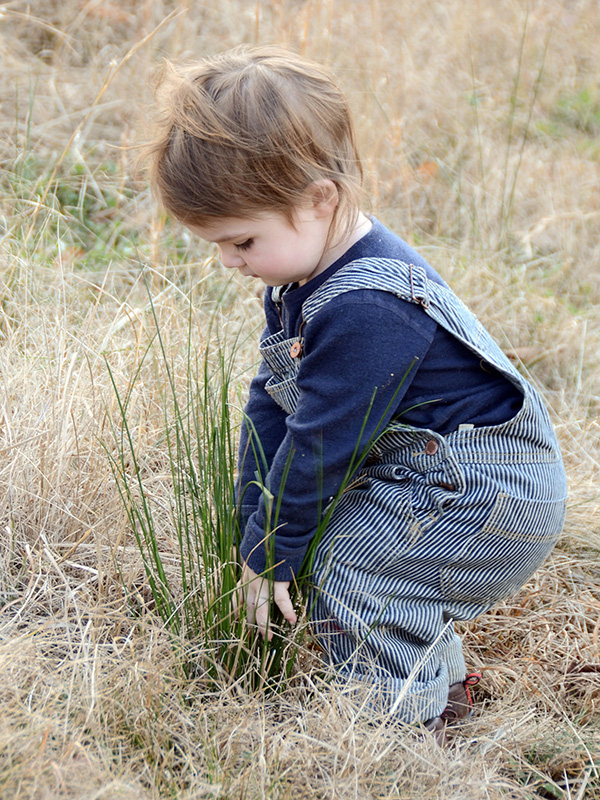
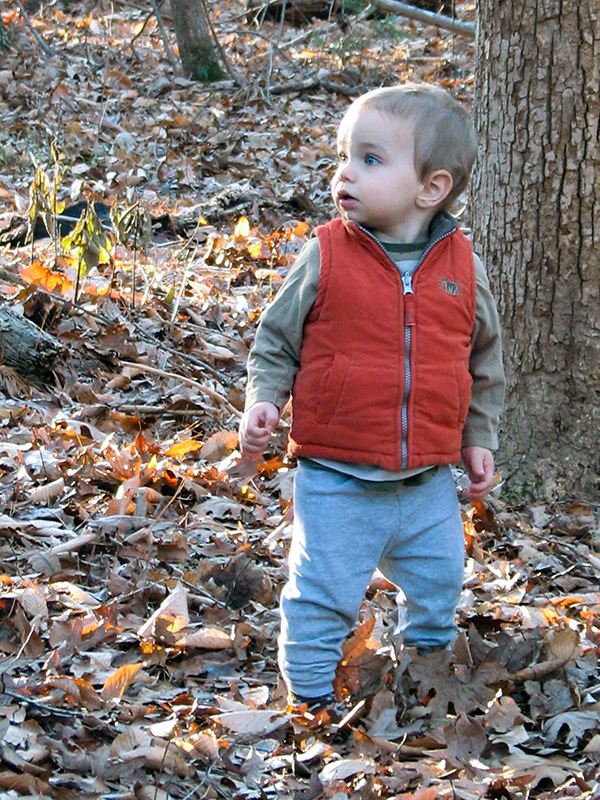
You can never be too young to explore the woods (with supervision)!
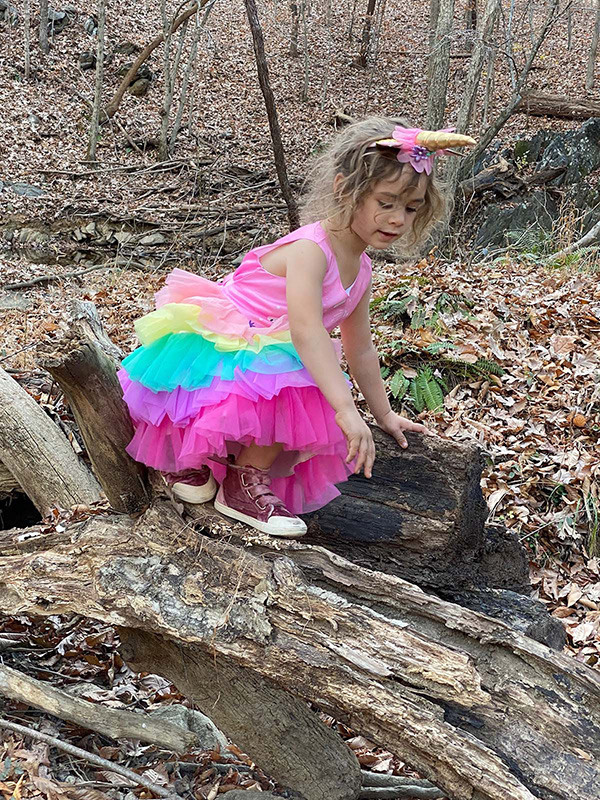
Even a grand-unicorn-daughter can enjoy exploring a forest!
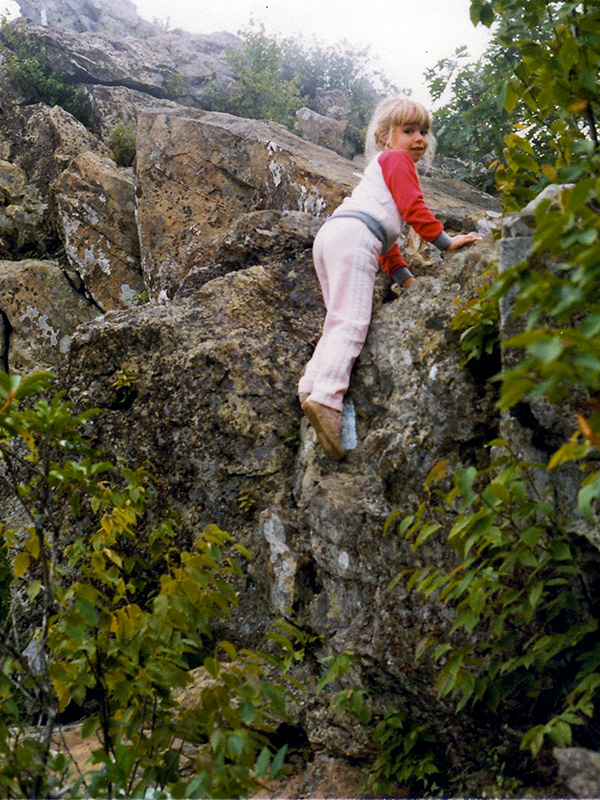
Children learn a lot by exploring in nature.
Here is our daughter (now the mother of two of our grandsons) many years ago, exploring in a national park.
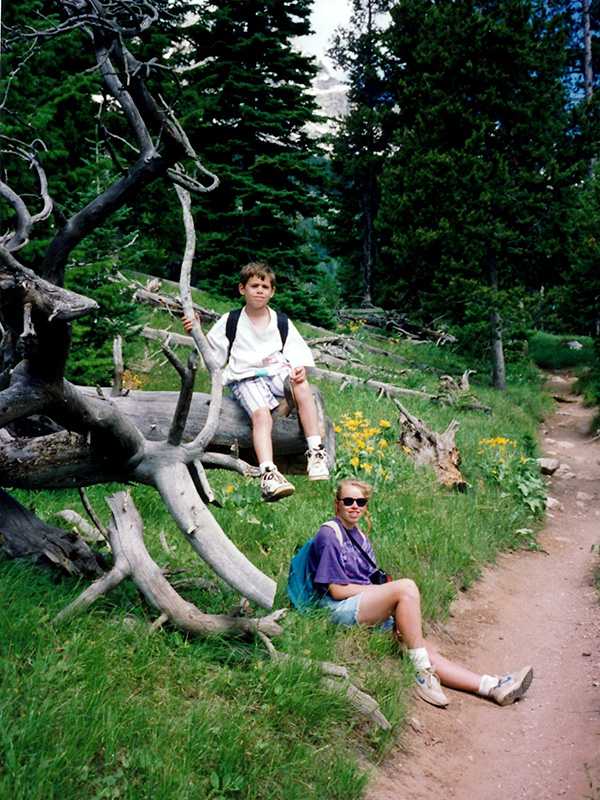
Here are our kids hiking in the Tetons decades ago.
Kids can have a wide variety of enriching experiences in nature — every day at home, but also on extended trips, such as the month-long camping trip we took to visit most of the national parks in the western states.
As people learn more about the importance of nature to children’s development, more resources for schools are becoming available.
Books for children
- Nature’s Best Hope (Young Readers’ Edition): How You Can Save the World in Your Own Yard by Doug Tallamy — This middle grade edition of the groundbreaking bestseller by Doug Tallamy will inspire kids to use their backyard to help save the planet.
- The Garden Next Door by Collin Pine and Tiffany Everett — A picture book for young children
Books about children and nature
- Noah’s Children: Restoring the Ecology of Childhood by Sara Stein—The author of the classic Noah’s Garden explains why children need contact with the natural world and offers ways to make this connection.
- Last Child in the Woods: Saving Our Children From Nature-Deficit Disorder by Richard Louv is a more recent book on the subject.
Other resources
- New York Times:
- National Wildlife Federation:
- The Dirt on Dirt – free PDF file; also other resources to help kids get dirty outdoors!
- It’s in the dirt! Bacteria in soil may make us happier, smarter – and it may be why farm kids have less asthma
- Kids in Nature: Growing outdoors – interview with Richard Louv and David Mizejewski
- Cool Green Science:
- Mass Audubon:
- Nature play days – Great collection of outdoor activities kids can do anywhere!
- Fall activities – Fun activities to do in fall
- The Humane Gardener:
- The Xerces Society:
- X Kids – Free materials designed for kids 8-11
- Audubon:
- Audubon for kids – A wealth of materials for 8-12 year olds
- Audubon birding adventures for kids – (a book to purchase)
- Cornell All About Birds:
- Explorer’s Guidebook – designed for schools, but anyone can download this free PDF
- Grist:
- Slate.com:
- Master Gardeners of Durham County:
- Growing a Greener World:
- VIDEO: Growing the next generation of gardeners – excellent! Shows kids gardening at home and in the neighborhood as well as in school (2020)
- Children and Nature Network:
- PennState Extension:
- Connecting children with nature – a 3-min video 3 tips to connect children with nature
Reflections
I’m lucky to have spent my childhood summers among woods, streams, meadows, and marshes, but most suburbanites have never searched for frogs’ eggs, caught fireflies in a jar, or peeked into a grassy nest of adorable baby mice. As the years pass, fewer and fewer people will long for the call of bullfrogs. Today’s children, growing up on lawns and pavements, will not even have nostalgia to guide them, and soon the animals will be not only missing but forgotten.
~ Sara Stein, Noah’s Garden
My point is a simple one: although organized exposure to nature is far better than no exposure at all, it is unlikely to achieve the goal of enabling kids to develop a personal relationship with the natural world. …
Scheduled expeditions to parks lack the solitude, the frequency, the extemporaneous opportunity, and the unhurried exposure to natural things that can come from a lazy afternoon within the safety of their own yard — if nature is in their yard.
~ Doug Tallamy, Nature’s Best Hope, p. 76, 2020
I am fighting for my future. Losing my future is not like losing an election or a few points on the stock market. At school, even in kindergarten, you teach us how to behave in the world. You teach us not to fight with others, to work things out, to respect others, to clean up our mess, not to hurt other creatures, to share, not be greedy. Then why do you go out and do the things you tell us not to do? …You grownups say you love us. But I challenge you, please, make your actions reflect your words.
Hear her whole amazing speech …
~ Severn Cullis-Suzuki, age 12, Rio, 1992; now director of the David Suzuki Foundation
If a child is to keep alive his inborn sense of wonder, he needs the companionship of at least one adult who can share it, rediscovering with him the joy, excitement and mystery of the world we live in.
~ Rachel Carson, Silent Spring
I did not find the world desolate when I entered it. My fathers planted for me before I arrived, so I plant for those who come after me.
~ The Talmud
We may differ about whether the universe was made by fiat, or by the laws of nature, but on this point we are in profound accord the Earth — with its gorgeous diversity of habitats and beings — belongs, if it belongs to any of us, to our children and their children and on into the distant future. It is not ours to squander.
~ Carl Sagan
Will urban sprawl spread so far that most people lose all touch with nature? Will the day come when the only bird a typical American child ever sees is a canary in a pet shop window? When the only wild animal he knows is a rat — glimpsed on a night drive through some city slum? When the only tree he touches is the cleverly fabricated plastic evergreen that shades his gifts on Christmas morning?
~ Frank N. Ikard, No. Am. Wildlife and Natural Resources Conference 1968
Teaching a child not to step on a caterpillar is as valuable to the child as it is to the caterpillar.
~ Bradley Millar
